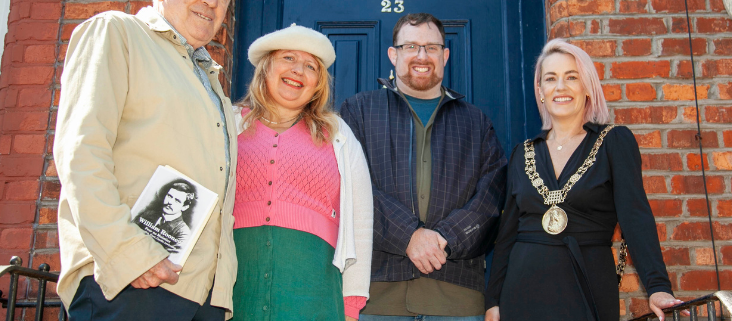Plaque dedicated to Poet, Journalist and Gaelic Revivalist William Rooney unveiled
23 Leinster Avenue off North Strand has been memorialised earlier today as the home of journalist, poet and Gaelic revivalist, William Rooney, at a Dublin City Council Commemorative Plaque unveiling by Lord Mayor of Dublin Emma Blain.
Born in 1873, Rooney was a one of the foremost figures of the Gaelic revival of the late 19th and early 20th Century. As one of the first members of the Irish Fireside Club, Rooney helped to promote nationalist reading and discussion, while also offering young people the chance to learn the Irish language. Rooney was close friends with Arthur Griffith, who collaborated on Rooney’s first article about notable graves in the Dublin area that appeared in the Evening Herald (1892). When the United Irishman was launched in 1899 with Arthur Griffith as editor, Rooney wrote most of the papers articles for two years using twelve pseudonyms.
Rooney was an active member in the Leinster Literary Society and the Celtic Literary Society, become the latter’s President and editing their journal An tSeanachaidhe, The Storyteller. When the Gaelic League was established Rooney was a founding member, although he disagreed with the non-political stance of the organisation.
Speaking at the unveiling, Lord Mayor of Dublin Emma Blain said, “I am honoured to be here on a day when such an influential figure in our history is being recognised. William Rooney provided a cultural foundation for Irish Independence, being revered during his time by some of Ireland’s most famous heroes, from Michael Collins to W.B. Yeats.”
Gerard Shannon read a poem by Thomas MacDonagh, On a Poet Patriot, written as a tribute to William Rooney stated that, “It’s great to see this plaque on the former home of William Rooney. His patriotic contribution to his country deserves recognition, as a tireless worker for the Gaelic revival and important nationalist causes. Though he died in 1901, many of his peers in the subsequent revolutionary decade noted his influence.”
The commemorative plaque unveiling at Rooney’s former home in North Strand, where he lived until his death and even hosted the first meeting of the Celtic Literary society, is part of Dublin City Council’s ongoing initiative to celebrate and honour notable Dubliners who have contributed to the city’s rich cultural and historical heritage.
The decision to erect the plaque was made by the Dublin City Council Commemorations & Naming Committee, whose chair, Deputy Lord Mayor Councillor Donna Cooney, said, “The Commemorative Plaques Scheme allows the City to formally commemorate people who have made a significant contribution to the life of Dublin. We welcome suggestions from the public for people and events to be commemorated, and full details are on the Council website.”





